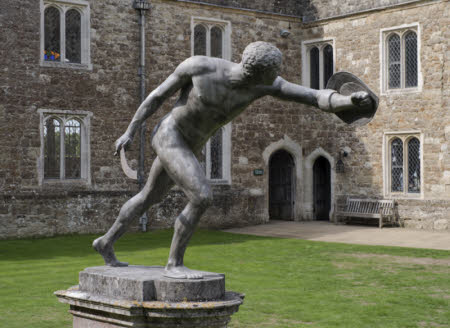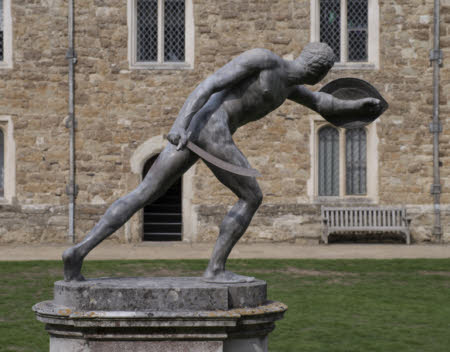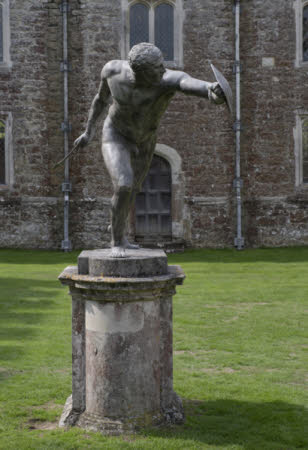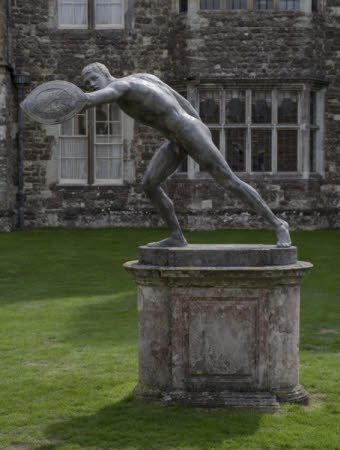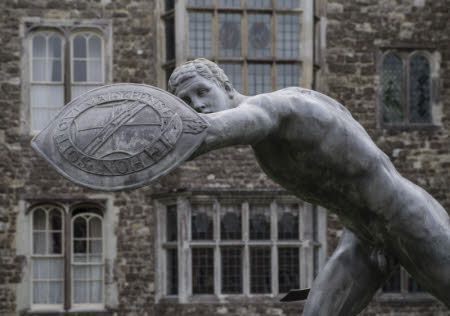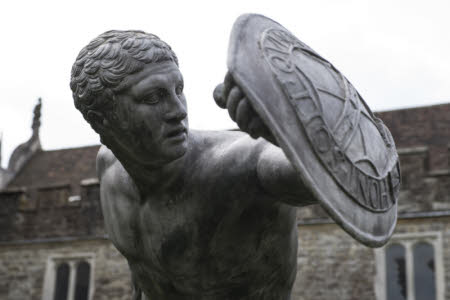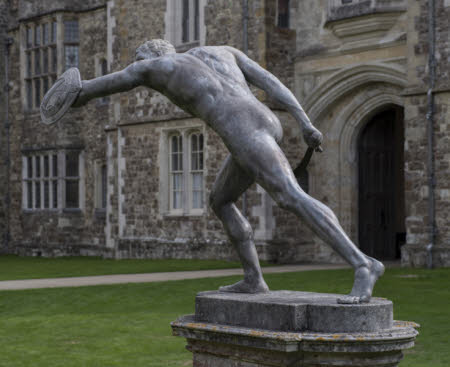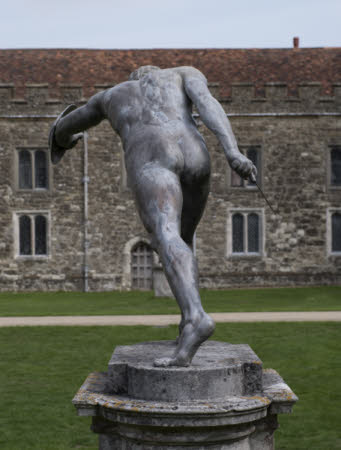Borghese Gladiator
Category
Art / Sculpture
Date
circa 1697
Materials
Lead, stone
Measurements
1350 x 1900 x 1040 mm
Order this imageCollection
Knole, Kent
NT 130066
Summary
Lead statue, Borghese Gladiator, a late seventeenth century copy after the antique marble statue dating from c. 100 BC (Louvre, Paris). A statue of a nude male figure, a warrior, rather than a gladiator, he is posed leaning forwards with his weight on his right leg, his left leg stretched behind him. His left arm is outstretched and he holds a shield in his left hand, he looks over his left shoulder. The original statue is signed ΑΓΑΣΙΑΣ ΔΩΣΙ ΘΕΟΥ ΕΦΕΣΙΟΣ ΕΠΟΙΕΙ [Agasias son of the Dositheus, Ephesus] on a supporting tree trunk behind the right leg; this feature is missing in the lead cast at Knole. The original Wrestler does not hold a shield in his left hand, although this was commonly added in later casts. The shield on the Knole sculpture has the Sackville arms embossed on it. The Knole statue also has a sword in his right hand, the original statue does not have a sword in his hand. The statue is displayed on a stone pedestal.
Full description
The Borghese Gladiator is one of the most revered and reproduced statues from antiquity. Now in the Louvre, Paris, it was once in the collection of the Borghese family where it gained its name. The statue dates from c. 100 BC and was carved by the sculptor Agasias of Ephesus (signed on the tree trunk), although it is believed to be a copy, or at least inspired by, an earlier bronze statue possibly by Lysippos. The statue was first recorded on 11 June 1611 when it was being restored shortly after its discovery at Nettuno, Italy. It remained in the Borghese collection until 1807 when it was purchased, along with many other Borghese antiquities, by Napoleon Bonaparte and taken to France. In 1629-30 the sculptor Hubert le Sueur (c.1580-1658) cast a copy of the statue in bronze for Charles I (now at Windsor Castle, Royal Collection). This made the statue well-known in England and by 1645 another cast in bronze was produced for the gardens at Wilton (possibly also by le Sueur), now at Houghton Hall. The statue was widely copied in sculptural form, both full size and smaller versions, but also in numerous drawings and paintings. The great sculptor, Bernini, greatly admired it and ranked it as one of the most beautiful statues he had ever seen. Although still widely referred to as a 'Gladiator', by the early eighteenth century commentators were starting to reject the previously assigned status of the figure, and were instead suggesting that he was a warrior instead. These discussions continued into the nineteenth century, resulting in the statue being known by a variety of names including, Discobolus, Fighting Gladiator, Heros Combattant and Borghese Warrior. The lead cast of the Borghese Gladiators at Knole appears to have been acquired by Charles Sackville, 6th Earl of Dorset (1643-2706) in 1697. A receipt from the sculptor, Richard Osgood (died c.1724) for 'Statuary work' included a bill 'For the Gladiator as agreed for' and 'For a Large Stone plinth and Shield wth my Lords Armes'. The same receipt also bills the Earl 'For the case for the Venus and pedestal that went to Knowell', referring to the Crouching Venus NT 130062. The receipt does not make clear if Osgood provided the lead casts of the Gladiators and the Crouching Venus, or just supplied the plinths and the shield with the Sackville arms for the Gladiators. Osgood owned premises at Hyde Park Corner, London, working alongside other leading lead figure manufacturers including John Nost the Elder, Edward Hurst and Josias Iback. Osgood and Nost collaborated on a commission for Hampton Court Palace in 1701, and it is also possible that they collaborated on the two large lead sculptures at Knole. In 1702 Nost supplied a marble of the Crouching Venus to Andrew I Archer for Umberslade Hall, Warwickshire, and possibly already had a mold for version in lead as early as 1697. Anna Moore (July 2018)
Provenance
Acquired by Charles Sackville, 6th Earl of Dorset (1643-1706) in 1697. A receipt dated 6 September 1697 from the sculptor Richard Osgood (died c.1724) bills the Earl 'For the Gladiator as agreed for' and 'For a Large stone plinth and Shield wth my Lords Armes'. A lead statue was recorded as being in the Green Court in the 1706 inventory of Knole, 'One Leaden Statue on a pedestall'. This could refer to either the Crouching Venus (NT 130062) or the Borghese Gladiator (NT 130066). The 1765 inventory records two statues in the Green Court: 'two Statues in the Green-Court'. On loan to the National Trust from the Sackville Trust.
References
Haskell and Penny 1981: Francis Haskell and Nicholas Penny, Taste and the Antique, The Lure of Classical Sculpture 1500 - 1900, New Haven and London, 1981, pp. 221-224, no. 43 Guilding 2014 Ruth Guilding, Owning the Past : Why the English collected Antique Sculpture, 1640 - 1840, Paul Mellon Centre for Studies in British Art, Yale University Press, 2014, p. 286, fig. 269 Sackville-West, V, Knole and the Sackvilles, 1923, p. 179
